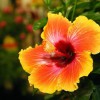 Horticultural consumers in Florida are interested in local and organically produced plants. But these terms can mean different things in different regions. UF/IFAS researchers conducted a survey last summer which suggests that consumers in central Florida define local as plants that are grown near where they are sold and identify the most important local benefits as product safety, quality, and community support. Organic plants are perceived as requiring fewer chemical additives and being healthier for the environment. The importance of these traits varies by plant type. This 5-page fact sheet was written by Hayk Khachatryan and Alicia Rihn, and published by the UF Department of Food and Resource Economics, February 2015.
Horticultural consumers in Florida are interested in local and organically produced plants. But these terms can mean different things in different regions. UF/IFAS researchers conducted a survey last summer which suggests that consumers in central Florida define local as plants that are grown near where they are sold and identify the most important local benefits as product safety, quality, and community support. Organic plants are perceived as requiring fewer chemical additives and being healthier for the environment. The importance of these traits varies by plant type. This 5-page fact sheet was written by Hayk Khachatryan and Alicia Rihn, and published by the UF Department of Food and Resource Economics, February 2015.
http://edis.ifas.ufl.edu/fe964
Tag: Organic Industry
FE732/FE732 Economics of the Organic Food Industry in Florida
FE732, an 8-page illustrated fact sheet by Thu-Vi Nguyen, Allen Wysocki, and Danielle Treadwell, delivers an overview of the organic industry in Florida, covering the definition of organic, requirements for organic certification, issues in the Florida organic industry, and major market outlets for organic products. Includes references. Published by the UF Department of Food and Resource Economics, September 2008.
http://edis.ifas.ufl.edu/FE732
HS1146/HS397 Understanding the ‘USDA Organic’ Label
HS-1146, a 6-page illustrated fact sheet by Danielle D. Treadwell and Mickie E. Swisher, briefly outlines the history of the USDAs National Organic Program (NOP), summarizes for consumers the benefits of government regulation of organic food products, and provides a guide for interpreting labels on products with organic ingredients. Includes references. Published by the UF Department of Horticultural Sciences, August 2008.
http://edis.ifas.ufl.edu/HS397